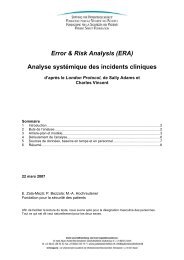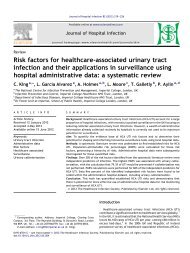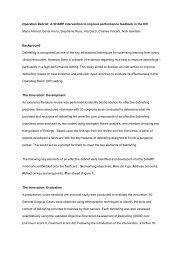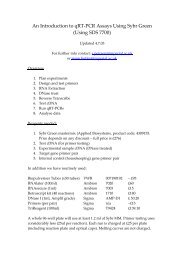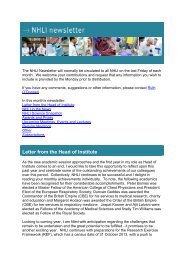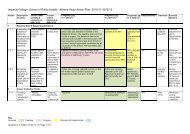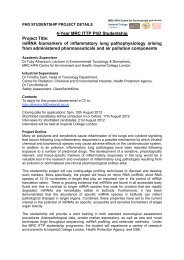QOF Plus Year 1 - Imperial College London
QOF Plus Year 1 - Imperial College London
QOF Plus Year 1 - Imperial College London
Create successful ePaper yourself
Turn your PDF publications into a flip-book with our unique Google optimized e-Paper software.
While both threshold types are remunerated as all-or-nothing targets, there is ongoing debatewithin the <strong>QOF</strong>+ Development Group as to how these might perform against scaled (as in existing<strong>QOF</strong>) or other reward schemes in terms of motivating improvement. A key effect of an all-ornorthingtarget is likely to be greater influence over the pattern of attainment seen inparticipating practices. Scaled rewards free practices to decide what represents an adequate levelof reward versus attainment for them. Notwithstanding the cushion effect of the Tolerancethreshold, this choice is effectively removed under the current scheme. Part of the reason for thisis a genuine desire to drive a ‘step-change’ in quality by the commissioners of the <strong>QOF</strong>+ project.However, there are still concerns that, despite efforts to set thresholds with reference to currentlevels of attainment, the all-or-nothing scheme may discourage engagement by poorerperforming practices. Evaluation over the next twelve months will aim to explore this issue with aview to considering possible alternative approaches for <strong>QOF</strong>+ 09/10. Schemes that wereconsidered during <strong>QOF</strong>+ development include per-practice target setting, multiple tierremuneration and non-linear scaled rewards (where the fraction of points awarded accelerates aspractices approach the upper threshold). The administrative burden associated with per-practicetarget setting is a significant concern, while it proved difficult to reconcile multiple tier paymentwith the capping requirements.A separate argument which requires further consideration is that, since exception reportingprovides recourse for all legitimate reasons for non-treatment of patients, there is no reason whyupper targets not be set at 100% (Fleetcroft et al. 2008).Methodology for point allocation for existing clinical indicatorsPayment under <strong>QOF</strong> is based on a points system. For the average practice in England (beforecorrection for list size and disease-specific prevalence), each point is currently worth £124.60.Each indicator has a fixed number of points allocated, a whole-numbered fraction of which areawarded in linear proportion to practice attainment. Achievement below the lower <strong>QOF</strong>threshold for each indicator results in no points being awarded, while practices who exceed theupper threshold do not receive additional points beyond the maximum available for the indicator.While the stated purpose of the point system is to reward “GPs and their staff for the volume andquantity of work done” (BMA NHS Confederation, 2003), information about how this process wasconducted – particularly for the first year of <strong>QOF</strong> (2004/05) – is limited. Roland (2004) describeshow point allocation was determined “partly by the academic advisory group *of the original <strong>QOF</strong>negotiation process] and partly by a formal scoring process undertaken by groups of familypractitioners in England and Scotland.” Fleetcroft and Cookson (2006) present a slightly differentaccount of “two small groups of GPs estimating the work required to achieve the different qualitycriteria,” but this must be viewed within the context of their argument that there is a disparitybetween point allocation and health outcomes. By contrast, guidance from the NHS Primary CareContracting Website states that:“there is no set workload represented by a <strong>QOF</strong> point… any local frameworks used byPMS contractors should be comparable to the National <strong>QOF</strong> in terms of the work neededto earn the same amount of money..”It is interesting to note that subsequent revisions of <strong>QOF</strong> have typically raised thresholds withminimal or no alterations to point allocation.106



